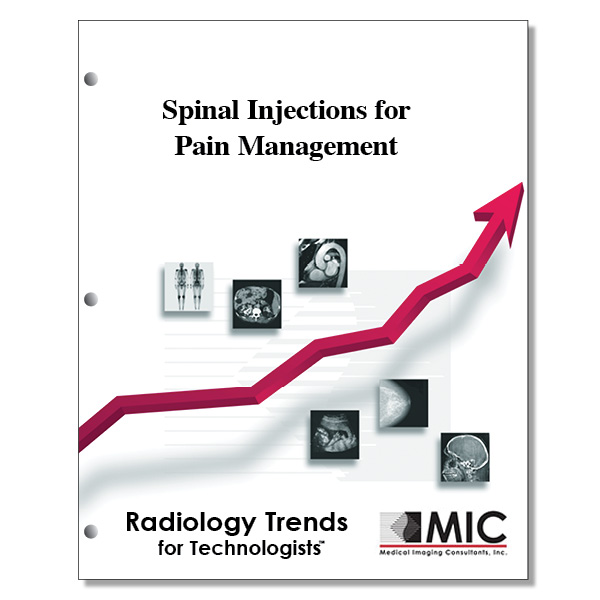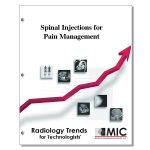

Spinal Injections for Pain Management
A description of image-guided spinal injection for pain management.
Course ID: Q00532 Category: Radiology Trends for Technologists Modalities: CT, MRI, Radiography, Vascular Interventional3.5 |
Satisfaction Guarantee |
$37.00
- Targeted CE
- Outline
- Objectives
Targeted CE per ARRT’s Discipline, Category, and Subcategory classification for enrollments starting after March 18, 2024:
[Note: Discipline-specific Targeted CE credits may be less than the total Category A credits approved for this course.]
Computed Tomography: 1.00
Procedures: 1.00
Head, Spine, and Musculoskeletal: 1.00
Magnetic Resonance Imaging: 1.00
Procedures: 1.00
Neurological: 1.00
Radiography: 1.00
Procedures: 1.00
Head, Spine and Pelvis Procedures: 1.00
Registered Radiologist Assistant: 3.50
Patient Care: 0.50
Patient Management: 0.25
Pharmacology: 0.25
Procedures: 3.00
Musculoskeletal and Endocrine Sections: 3.00
Outline
- Introduction
- Corticosteroid Properties
- Interaction with Patients
- The Interview
- The Blow-by-Blow
- The Teachable Moment
- The Discharge
- Role of Imaging in Procedural Selection
- Pearls and Pitfalls of Fluoroscopy-guided Injections
- Risk and Risk Mitigation
- Procedural Tips and Techniques
- Conclusion
Objectives
Upon completion of this course, students will:
- identify the decade during which epidural steroid injection became a cornerstone in the management of low back pain and sciatica
- list the imaging modalities that helped spur growth of interventional procedures in the spine
- list the procedures added to lumbar and cervical ESIs as fluoroscopic techniques evolved
- describe the increase in lumbar ESI rates for spinal stenosis from 1994 to 2011
- identify common nonparticulate corticosteroid preparations
- identify the particulate corticosteroid preparation which has the largest particles
- identify the particulate corticosteroid preparation which has the smallest particles
- list the structured interactions that take place while the patient lies on the fluoroscopy table
- list the goals of the patient interview described by the author
- describe the patient complaint that warrants a facet cyst rupture procedure
- describe the patient complaint for which Baastrup syndrome should be considered
- identify unresolvable issues that should be uncovered during the patient interview
- list the individuals who should be informed and engaged by the blow-by-blow
- describe when the teachable moment begins
- describe how long it typically takes for an injected particulate corticosteroid to reach full effectiveness
- describe the length of time for which steroid injection can break the inflammation cycle and relieve pain
- identify the recommended treatment option if dermatomal information reveals a specific pain generator in older patients with chronic unilateral radiculopathy
- describe the leading reason for spinal surgery
- identify the recommended procedure when MR imaging shows multi-level stenosis
- identify the spinal level where the radiologist should inject in patients with chronic nonlocalizing low back pain
- compare CT and fluoroscopy for needle placement during spine procedures
- list the factors that increase the risk for bleeding during a spinal procedure
- describe the greatest threat during a spinal procedure that requires surgical intervention to prevent permanent neurologic sequelae
- list the options for patients with known or suspected reactions to iodinated contrast material
- describe why digital subtraction fluoroscopy is a useful technique when using gadolinium-based contrast agents
- identify the spinal level where vascular cannulation during lumbar NRBs is more than twice as likely to occur
- describe the length of time that diabetic patients should monitor their blood glucose levels after a spine procedure
- list the negative outcomes from repeated injections of particulate steroids at short intervals
- list appropriate anesthetics for spine procedures
- list the patient groups in which anesthetics should be used with caution
- describe the patient positioning for the majority of spine procedures
- identify the spinal procedure for which 6-9 mg of betamethasone acetate is the recommended corticosteroid dosage
- identify the spinal procedure for which 40 mg of triamcinalone acetonide mixed with an anesthetic is the recommended corticosteroid dosage
- describe the systematic maneuvers during fluoroscopic setup for a spine procedure
- list the reasons for archival of fluoroscopic images obtained during spine procedures
- describe the anatomic space bounded by the pedicle, the exiting nerve, and the vertebral body
- describe the anatomic space bounded by the facet joint, the exiting nerve, and the caudal vertebral body
- list the agents injected during selective lumbosacral NRB
- list the vessels that may be in the needle path during fluoroscopy-guided cervical NRB with an anterolateral approach
- describe the needle length for a cervical transforaminal NRB
- identify the spinal level that has the least dorsal epidural fat in normal spines
- describe the critical juncture during lumbar interlaminar ESI
- describe the volume of contrast agent that can cause injection pressure to increase unexpectedly during lumbar interlaminar ESI
- identify the spine procedure with the goal of diffuse epidural spread of the injectate
- list potential causes of facet-related pain in patients with early osteoarthritis
